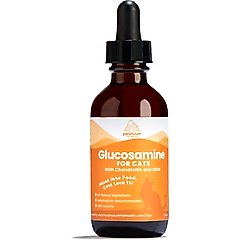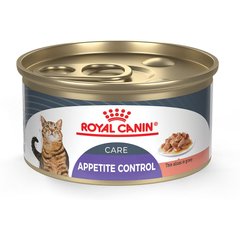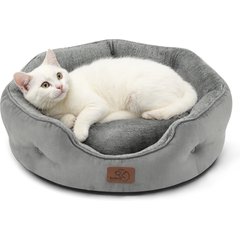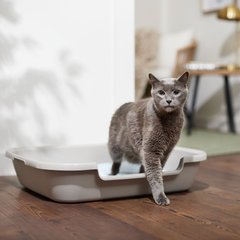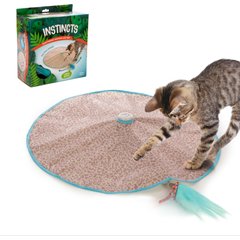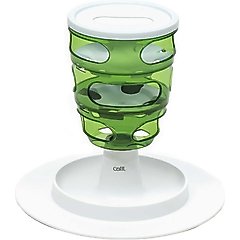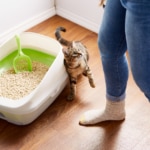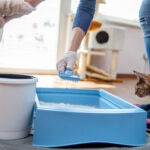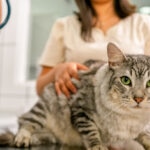What Is Hip Dysplasia in Cats? How Is It Diagnosed?
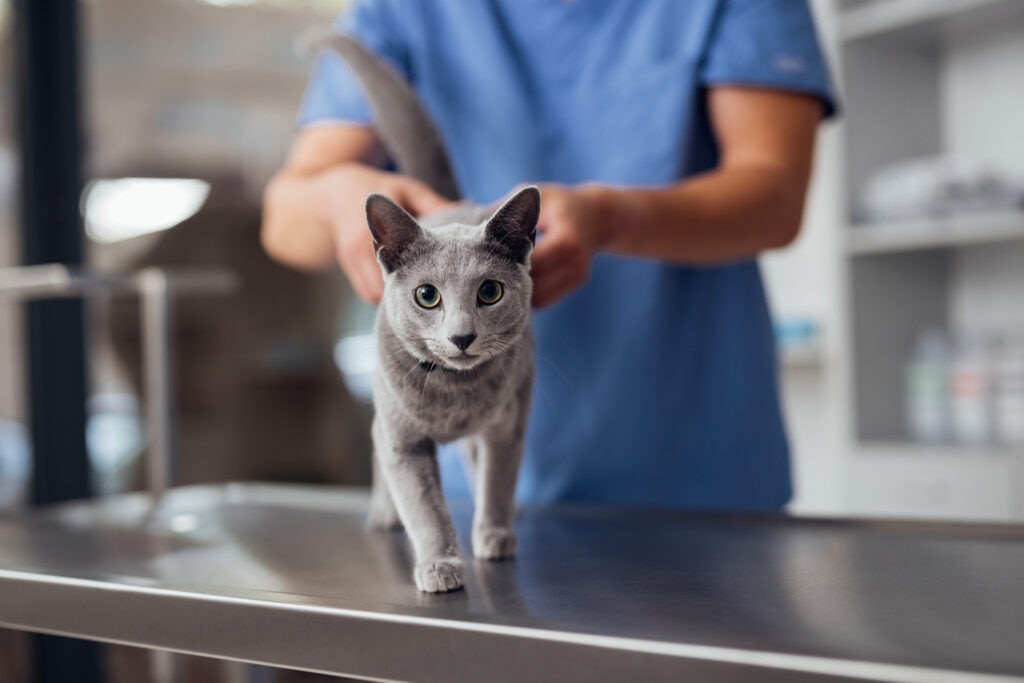
Photo by FreshSplash via E+/Getty Images
Does your cat seem less active, hesitate before jumping to a favorite perch, skip it altogether, or struggle to get up after resting?
You may also notice changes in behavior, such as irritability or changes in grooming habits.
Hip dysplasia could be to blame, especially in large cat breeds prone to the condition, such as Maine Coons, Persians, and Norwegian Forest Cats.
To help you better understand hip dysplasia in cats, experts shared the signs to watch for, causes, and treatment options, ranging from at-home management to surgery.
With the right plan, cats with hip problems can live happy, active lives.
Key Takeaways
- Hip dysplasia is a condition in which the hip joint (made of the pelvic bone and femoral head) does not align properly. Cats may be born with hip dysplasia or develop it after an injury.
- Hip dysplasia in cats is most common in large or big-boned breeds such as Maine Coons, Persians, and Norwegian Forest Cats, though it can affect any cat, particularly those who are overweight.
- Signs of hip dysplasia in cats include stiffness, difficulty jumping, changes in grooming habits, and irritability.
- Surgery is not always recommended to treat hip dysplasia in cats. It may be managed successfully at home with a combination of lifestyle adjustments, pain management, joint supplements, and gentle exercise.
What Is Hip Dysplasia in Cats?
Hip dysplasia in cats happens when the hip joint, comprising the pelvic bone and the head of the femur (leg bone), doesn’t line up properly. This misalignment causes pain and leads to early-onset arthritis from abnormal wear on the joint.
The condition is most often hereditary and present in both hips.
“In cats, hip dysplasia develops gradually. Some show signs as kittens or young adults, while others only experience symptoms later in life as arthritis progresses,” says Ashly Smith, DVM, veterinarian and regional medical director for Small Door Veterinary.
Hip dysplasia may be more common in cats than many realize. Studies suggest it affects anywhere from 6% to 32% of cats.
What Are the Signs of Hip Dysplasia in Cats?
Smith says hereditary hip dysplasia often appears earlier in life and progresses steadily, while non-hereditary cases may develop later and vary in severity.
The condition can be mild, moderate, or severe, with symptoms that may include:
- Hesitation or difficulty jumping onto furniture or climbing stairs
- Stiffness, limping, or an abnormal gait, especially after resting
- Less interest in play or exploring their usual spots
- Changes in grooming habits, such as overgrooming the hind end, grooming less, or missing spots, causing matting and an unkempt coat
- Irritability or changes in mood
- Sleeping more or choosing easier-to-reach resting spots
- Litter box issues, such as accidents or avoiding the box because of difficulty getting in and out
What Causes Hip Dysplasia in Cats?
Hip dysplasia in cats is often hereditary, meaning cats are born with genetic factors for it. Environmental stressors, such as obesity, can worsen the condition. Large breed cats may also have a higher risk.
Non-hereditary cases may result from injury, such as a broken pelvis, or from being overweight. Because extra weight puts added strain on the joints, overweight cats are more prone to injury.
How Do Veterinarians Diagnose Hip Dysplasia in Cats?
If you suspect your cat is in pain or having difficulty with everyday activities, schedule an appointment with your veterinarian.
To diagnose or rule out hip dysplasia, your vet will:
- Perform a physical exam: The vet will move your cat’s hip and leg to check for looseness in the ligaments or signs of pain. Orthopedic tests may sometimes be repeated under anesthesia for accuracy. A neurologic exam of your cats’ reflexes can determine an orthopedic issue versus a neurologic condition, both of which might have the same symptoms.
- Order imaging tests: X-rays are commonly used to check joint structure and look for signs of arthritis, while a CT or MRI may be recommended if more detailed imaging is needed.
Based on the exam and imaging, your veterinarian will assign the condition a grade:
- Mild: Slight joint laxity (looseness in the ligaments), minimal arthritis
- Moderate: Clear subluxation (partial dislocation of the joint) with some cartilage damage
- Severe: Full joint dislocation or advanced arthritis
How Do Veterinarians Treat or Manage Hip Dysplasia in Cats?
Hip dysplasia doesn’t always need surgery. Many cats’ conditions can be managed with home exercise plans, in-office physical therapy, weight management, joint supplements, and pain medication.
According to Wendy Davies, CVT, CCRVN, a veterinary rehabilitation technician at the University of Florida Small Animal Hospital, “In milder cases, we may be able to just concentrate on exercises to strengthen the muscles surrounding the hip joint to help seat it into place.”
Smith says that the choice between home management and surgery depends on several factors:
- Grade: Mild cases often respond well to medical management, while severe cases may require surgery.
- Age: Younger cats typically tolerate surgery better.
- Weight: Obesity can worsen symptoms and complicate treatment.
- Activity level: More active cats may benefit from surgical options.
- Budget: Cost and a pet parent’s resources play a role in what treatments are practical.
Based on these factors, your veterinarian may recommend either nonsurgical management or surgery:
Nonsurgical management
- Weight loss to reduce stress on the joints
- Pain relief with nonsteroidal anti-inflammatory drugs (NSAIDs) or other prescribed medications
- Joint supplements (such as glucosamine, chondroitin, or omega-3 fatty acids)
- Physical therapy or gentle exercises to maintain muscle strength
Recommended Product
Some cats may benefit from formal rehabilitation at the hospital or in a clinic, in addition to an at-home exercise plan, Davies says. This can include therapies such as walking on an underwater treadmill to safely build strength in the hind limb muscles.
Surgical options
- Femoral head ostectomy (FHO): Removal of the femoral head (the ball of the hip joint)
- Total hip replacement (rare in cats): Reserved for the most severe, debilitating cases
After surgery, your cat may need an at-home exercise plan or formal physical therapy and rehabilitation in a veterinary hospital or clinic.
Maintaining an ideal weight long-term is one of the biggest factors in how successful the surgery and recovery will be.
“Success would be considered a happy cat that eats, drinks, and uses the litter box comfortably,” Davies says.
How Can I Help My Cat Feel More Comfortable?
You can make simple changes at home to help a cat with hip dysplasia feel more comfortable and supported each day.
Maintain a Healthy Weight
Keeping your cat at a healthy weight is very important for minimizing injury and stress on the joints. Give your cat a balanced diet by using a vet-recommended weight–management cat food, like Royal Canin Appetite Control.
Recommended Product
Provide a Supportive Cat Bed
“A good cat bed can support joint health, especially for senior cats or those with arthritis,” says Bethany Hsia, DVM, veterinarian and one of the co-founders of CodaPet. She especially recommends orthopedic cat beds, like this Bedsure round cushion, for cats with hip dysplasia. These beds reduce pressure on sore joints by distributing the cat’s weight evenly.
Recommended Product
Feed on a Lowered Surface
You can make mealtime easier for a cat with hip dysplasia by placing their food on a lowered surface or directly on the floor. If you usually keep bowls out of reach because of kids or other pets, a feeder such as the SureFeed microchip feeder can solve this issue, as it only opens for the programmed pet.
Recommended Product
Choose a Low-Entry Litter Box
A low-entry litter box, like this Frisco litter box, makes bathroom breaks more accessible and less painful. Cats with hip dysplasia can struggle with high-sided boxes, so a shallow entry helps them maintain independence and comfort.
Recommended Product
Encourage Safe Exercise
Exercise is still important. “Cats with hip dysplasia can absolutely still enjoy playtime and activity,” Davies says. Focus on ground-level toys and puzzles, like the SmartyKat Hidden Hijinks or this Catit feeder, instead of encouraging high jumps.
Recommended Products
How Do I Prevent Hip Dysplasia in My Cat?
Minimize the risk of hip dysplasia in your cat with these tips:
Maintain a Healthy Weight
Keeping your cat at a healthy weight is the best way to prevent injuries and the progression of hip dysplasia. “Excess weight adds tremendous pressure on all their joints and can lead to long-term pain and health issues,” Davies says. Maintaining a healthy weight contributes to a longer, healthier life for your cat.
Choose a Reputable Breeder
Selecting a reputable breeder can help reduce the risk of hereditary hip dysplasia. Reputable breeders screen for genetic conditions and avoid breeding cats with signs of hereditary diseases such as hip dysplasia.
Schedule Regular Wellness Exams
Even if your cat seems healthy and pain–free, don’t skip routine wellness exams. These checkups are your cat’s first line of defense for catching problems early, before they become severe.
FAQs About Hip Dysplasia in Cats
What does cat hip dysplasia look like?
Cats with hip dysplasia often show reduced activity, reluctance to jump or climb, and difficulty getting up, along with limping, stiffness, or an abnormal gait. Because the condition is painful, cats may also have behavioral changes, such as irritability or decreased grooming.
How much does it cost to fix hip dysplasia in cats?
A femoral head ostectomy (FHO) can cost between $1,200 and $2,500 or more per hip, including pre-surgical blood work, anesthesia, the procedure, and post-surgical care. Because hereditary hip dysplasia often affects both hips, the total cost may double.
How do you treat dysplasia in cats?
Surgery isn’t always necessary to treat hip dysplasia. Veterinarians may instead recommend physical therapy, weight management, pain medications, and changes to the home.
What causes dysplasia in cats?
Hip dysplasia in cats is often hereditary, meaning they are born with a genetic predisposition. It can also be caused by excess weight or result from injuries, such as a broken pelvis.
